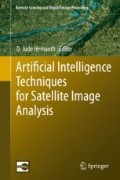Abstract
This chapter aims to use hyperspectral imagery to categorize saline blank classes amidst mangrove mixtures and analyze its changing patterns in the Sunderban Mangrove Forests of West Bengal, India. This research derives fractional abundance of mangrove endmembers at subpixel level with Fully Constrained Linear Spectral Unmixing (FCLSU) based on Least Square Error optimization criteria. NFINDR algorithm has been applied on time series hyperspectral image data of 2011 and 2014 to recognize pure saline blank and mangrove endmembers in the thickly forested study area followed by FCLSU to estimate mangrove species distribution maps of 2 years. The estimates in location 21° 34′ 24.81′′N and 88° 17′ 36.89′′E indicate a pure saline blank patch showing 74.47% occurrence with Phoenix paludosa, Avicennia alba, and Ceriops decandra showing 9.87%, 12.67%, and 2.99% presence in 2011. In 2014, the coordinate shows an increase in occurrence of saline blanks and Ceriops decandra but reduction in Phoenix paludosa and Avicennia alba. Ceriops decandra are salt-tolerant mangrove species that show an increase in abundance with increase in saline blanks. Phoenix paludosa which is salt intolerant shows a decrease in abundance with increase in saline blank areas. It is observed that mangroves, namely, Excoecaria agallocha and Ceriops decandra, are common and dominant around the saline blank areas. Salt-tolerant mangroves such as Avicennia marina and Avicennia alba are also observed to survive in certain locations of saline blanks.
Access this chapter
Tax calculation will be finalised at checkout
Purchases are for personal use only
References
Mohanty S (2015) Mangrove denundation scar on sanctuary. Indian Express News, 24th May, 2015. http://www.newindianexpress.com/states/odisha/Mangrove-Denudation-Scar-on-Sanctuary/2015/05/24/article2830205.ece
Chowdhury A, Maiti SKA (2014) Comparative study of variations in mangrove biodiversity at central and eastern parts of the Sundarban Biosphere Reserve, India. Am Int J Res Formal Appl Nat Sci 5(1):27–31
GhoshThakur D (2009) Saline poison in Sunderban ecosystem. Anandabazar News, 4th December
Giri S, Mukhopadhyay A, Hazra S, Mukherjee S, Roy D, Ghosh S, Ghosh T, Mitra D (2014) A study on abundance and distribution of mangrove species in Indian Sundarban using remote sensing technique. J Coast Conserv 18(4):359–367
Nayak S, Bahuguna A (2001) Application of remote sensing data to monitor mangroves and other coastal vegetation of India. Int J Remote Sens 30(4):195–213
Samanta K, Hazra S (2012) Landuse/landcover change study of Jharkhali Island Sundarbans, West Bengal using remote sensing and GIS. Int J Geom Geosci 3(2):299
Manson FJ, Loneragan NR, Phinn SR (2003) Spatial and temporal variation in distribution of mangroves in Moreton Bay, subtropical Australia: a comparison of pattern metrics and change detection analyses based on aerial photographs. Estuar Coast Shelf Sci 57(4):653–666
Giri C, Pengra B, Zhu Z, Singh A, Tieszen LL (2007) Monitoring mangrove forest dynamics of the Sundarbans in Bangladesh and India using multi-temporal satellite data from 1973 to 2000. Estuar Coast Shelf Sci 73(1–2):91–100
Muttitanon W, Tripathi NK (2005) Land use/land cover changes in the coastal zone of Ban Don Bay, Thailand using Landsat 5 TM data. Int J Remote Sens 26(11):2311–2323
Eslami-Andargoli L, Dale PER, Sipe N, Chaseling J (2009) Mangrove expansion and rainfall patterns in Moreton Bay, Southeast Queensland, Australia. Estuar Coast Shelf Sci 85(2):292–298
Lucas RM, Mitchell AL, Rosenqvist AKE, Proisy C, Melius A, Ticehurst C (2007) The potential of Lband SAR for quantifying mangrove characteristics and change: case studies from the tropics. Aquat Conserv Mar Freshwat Ecosyst 17(3):245–264
Conchedda G, Durieux L, Mayaux P (2008) An object-based method for mapping and change analysis in mangrove ecosystems. ISPRS J Photogramm Remote Sens 63(5):578–589
Haboudane D, Miller JR, Pattey E, Zarco-Tejada PJ, Strachan IB (2004) Hyperspectral vegetation indices and novel algorithms for predicting green LAI of crop canopies: modeling and validation in the context of precision agriculture. Remote Sens Environ 90(3):337–352
Winter ME (1999) N-FINDR: an algorithm for fast autonomous spectral end-member determination in hyperspectral data. In: SPIE’s international symposium on optical science, engineering, and instrumentation, pp 266–275
Du Q, Raksuntorn N, Younan NH, King RL (2008) Variants of N-FINDR algorithm for endmember extraction. SPIE Remote Sens 7109:71090G1-8
Author information
Authors and Affiliations
Editor information
Editors and Affiliations
Rights and permissions
Copyright information
© 2020 Springer Nature Switzerland AG
About this chapter
Cite this chapter
Ghosh, D., Chakravortty, S. (2020). Change Detection of Tropical Mangrove Ecosystem with Subpixel Classification of Time Series Hyperspectral Imagery. In: Hemanth, D. (eds) Artificial Intelligence Techniques for Satellite Image Analysis. Remote Sensing and Digital Image Processing, vol 24. Springer, Cham. https://doi.org/10.1007/978-3-030-24178-0_9
Download citation
DOI: https://doi.org/10.1007/978-3-030-24178-0_9
Published:
Publisher Name: Springer, Cham
Print ISBN: 978-3-030-24177-3
Online ISBN: 978-3-030-24178-0
eBook Packages: Earth and Environmental ScienceEarth and Environmental Science (R0)

